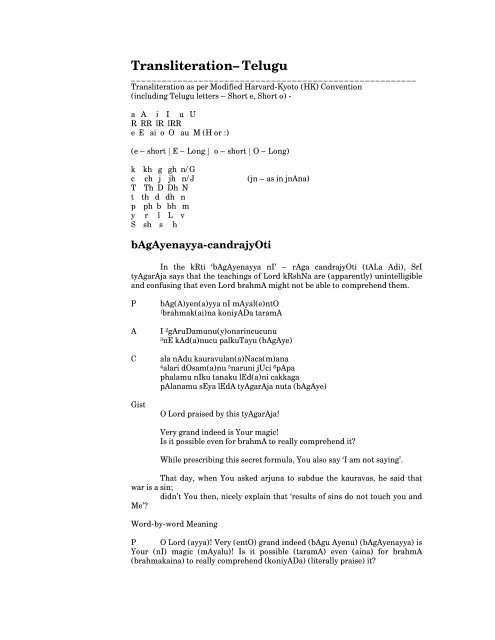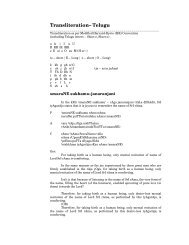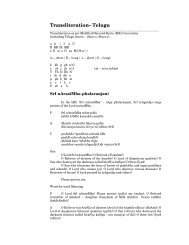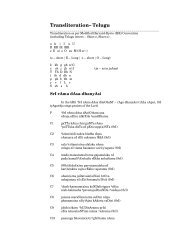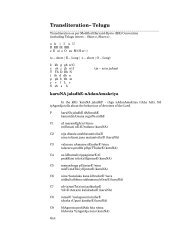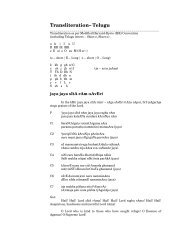TransliterationâTelugu
TransliterationâTelugu
TransliterationâTelugu
- No tags were found...
Create successful ePaper yourself
Turn your PDF publications into a flip-book with our unique Google optimized e-Paper software.
Transliteration–Telugu_______________________________________________________Transliteration as per Modified Harvard-Kyoto (HK) Convention(including Telugu letters – Short e, Short o) -a A i I u UR RR lR lRRe E ai o O au M (H or :)(e – short | E – Long | o – short | O – Long)k kh g gh n/Gc ch j jh n/J (jn – as in jnAna)T Th D Dh Nt th d dh np ph b bh my r l L vS sh s hbAgAyenayya-candrajyOtiIn the kRti ‘bAgAyenayya nI’ – rAga candrajyOti (tALa Adi), SrItyAgarAja says that the teachings of Lord kRshNa are (apparently) unintelligibleand confusing that even Lord brahmA might not be able to comprehend them.PACGistbAg(A)yen(a)yya nI mAyal(e)ntO1 brahmak(ai)na koniyADa taramAI 2 gAruDamunu(y)onarincucunu3 nE kAd(a)nucu palkuTayu (bAgAye)ala nAdu kauravulan(a)Naca(m)ana4 alari dOsam(a)nu 5 naruni jUci 6 pApaphalamu nIku tanaku lEd(a)ni cakkagapAlanamu sEya lEdA tyAgarAja nuta (bAgAye)O Lord praised by this tyAgarAja!Very grand indeed is Your magic!Is it possible even for brahmA to really comprehend it?While prescribing this secret formula, You also say ‘I am not saying’.That day, when You asked arjuna to subdue the kauravas, he said thatwar is a sin;didn’t You then, nicely explain that ‘results of sins do not touch you andMe’?Word-by-word MeaningP O Lord (ayya)! Very (entO) grand indeed (bAgu Ayenu) (bAgAyenayya) isYour (nI) magic (mAyalu)! Is it possible (taramA) even (aina) for brahmA(brahmakaina) to really comprehend (koniyADa) (literally praise) it?
A While prescribing (onarincucunu) this (I) secret formula (gAruDamunu)(gAruDamunuyonarincucunu), You also say (palkuTayu) ‘I (nE) am not (kAdu)(kAdanucu) (saying)’.O Lord! Very grand indeed is Your magic! Is it possible even for brahmAto really comprehend it?C Looking at (jUci) arjuna (naruni) (literally man), who said (anu) that war(alari) is a sin (dOsamu) (dOsamanu), when You asked (ana) him that (ala) day(nAdu) to subdue (aNaca) the kauravas (kauravalunu) (kauravulanaNacamana),didn’t You nicely (cakkaga) explain (pAlanamu sEya lEdA) (literallyprotect) that (ani) ‘results (phalamu) of sins (pApa) do not touch (lEdu) (lEdani)you (nIku) and Me (tanaku)’?O Lord praised (nuta) by this tyAgarAja! Very grand indeed is Yourmagic! Is it possible even for brahmA to really comprehend it?Notes –Variations –References –2 – gAruDamu – secret formula - a spell to remove poison, delusion etc.To know more about ‘garuDa mantra’, please visit -http://www.ramanuja.org/sv/bhakti/archives/apr97/0033.html3 – nE kAdanucu – the following verse from SrImad-bhagavad-gItA isalso relevant –Lord kRshNa said -vRshNInAM vAsudEvO(a)smi pANDavAnAM dhananjayaH |munInAmapyaham vyAsaH kavInAm-uSanA kaviH || X.37 ||“Of the vRshNis I am vAsudEva; of the pANDavas, dhananjaya; and alsoof the munis I am vyAsa; of the sages, uSanas the sage.”(All translations by Swami Swarupananda)vRshNi is the lineage of kRshNa. The implication is that ‘thoughapparently, I am kRshNa of the lineage of vRshNi, I am also You, therefore I amnot I (and similarly, you or not you).’4 – alari dOsamu - The following verses of SrImad bhagavad gItA arerelevant –arjuna said –dRshTvEmaM svajanaM kRshNa yuyutsuM samupasthitaM |sIdanti mama gAtrANi mukhaM ca pariSushyati ||ahO bata mahat pApaM kartuM vyavasitA vayaM |yadrAjya sukha lObhEna hantuM svajanam-udyatAH || I. 28, 45 ||“Seeing, O kRshNa, these my kinsmen gathered here eager for fight, mylimbs fail me and my mouth is parched.Alas! We are involved in a great sin, in that we are prepared to slay ourkinsmen, out of greed for the pleasures for a kingdom.”5 – naruni jUci – The word ‘nara’ used for arjuna is not to be taken inliteral sense as ‘man’. arjuna – kRshNa are known as ‘nara - nArAyaNa’; gItApropounded by SrI kRshNa is known as ‘kRshNa – arjuna samvAda’ and also‘nara nArAyaNa samvAda’. Please refer to website for more details –http://www.dlshq.org/religions/gita_krishna.htm
Please refer to SrImad-bhAgavataM, Book 12, Chapter 8 about sagesnara, nArAyaNa - http://vedabase.net/sb/12/8/en1“They that were nara and nArayaNa in days of yore are now arjuna andkESava.” – mahAbhArata –Book 5, Chapter 96 –http://www.sacred-texts.com/hin/m05/m05096.htm6 – pApa phalamu nIku tanaku lEdu – The follwing verses from SrImadbhagavad-gItAare relevant -Lord kRshNa said –ya EnaM vEtti hantAraM yaScainaM manyatE hataM |ubhau tau na vijAnItO nAyaM hanti na hanyatE || II. 19 ||“He who takes this Self to be the slayer, and he who takes It to be theslain, neither of these knows. It does not slay, not is it slain.”Comments -1 - brahmakaina koniyADa taramA – is it possible even for brahmA toapplaud it – being incomprehensible.2 – gAruDamunu – The statement of Lord kRshNa as brought in caraNais meant here. Therefore, the caraNa should be read first and then the anupallavi– that is the sequence in this kRti.4 – alari – this is how it is given in all the books. In one book, this hasbeen translated as ‘trembled’; in another book, as ‘hesitated’. But, the word ‘alaru’does not have any such meaning. Purely from prAsa – anuprAsa point of view,word beginning with ‘ala’ seems to be correct. The meaning of the word (alari) is‘unprotected’, ‘destitute’, anAtha’ – none of these words fit in the context.Therefore, the word seems to be doubtful.‘alaru’ in Telugu means ‘blossom’, ‘please’, ‘gratify’. The word ‘adaru’ inTelugu means ‘frighten’ etc. However, the Tamil word ‘alaru’ means ‘frighten’.The nearest telugu word ‘allari’ means ‘quarrel’, ‘affray’ etc. It is not clear whetherthis word has been used in the meaning of ‘war’.Has SrI tyAgarAja used a Tamil word ‘alari’ here or is the word ‘adari’ or‘allari’? In any case, it has been translated as ‘war’ here.Devanagari{É. ¤ÉÉ(MÉÉ)ªÉä(xÉ)ªªÉ xÉÒ ¨ÉɪÉ(äô)xiÉÉä¥ÉÀ(Eèò)xÉ EòÉäÊxɪÉÉb÷ iÉ®ú¨ÉÉ+.
English with Special Characterspa. b¡(g¡)ye(na)yya n¢ m¡ya(le)nt°brahma(kai)na koniy¡·a taram¡a. ¢ g¡ru·amunu(yo)nariμcucunun® k¡(da)nucu palkuayu (b¡)ca. ala n¡·u kauravula(na)¸aca(ma)naalari d°sa(ma)nu naruni j£ci p¡paphalamu n¢ku tanaku l®(da)ni cakkagap¡lanamu s®ya l®d¡ ty¡gar¡ja nuta (b¡)Teluguxms. ËØ(gS)¹¸V(©«s)¸RVù ¬ds ª«sW¸RV(ÛÍÁ)©¯[òúÊÁx¤¦¦¦ø(\ZNP)©«s N]¬s¸RW²R »R½LRiª«sW@. C gSLRiV²Rª«sVV©«sV(¹¸VV)©«sLjiÄÁVè¿RÁV©«sV®©s[ NS(μR)©«sV¿RÁV xmsÌÁVäÈÁ¸RVV (ËØ)¿RÁ. @ÌÁ ©y²RV N_LRiª«soÌÁ(©«s)ßá¿RÁ(ª«sV)©«s@ÌÁLji μ][xqs(ª«sV)©«sV ©«sLRiV¬s ÇÁÚÀÁ FyxmsxmnsÌÁª«sVV ¬dsNRPV »R½©«sNRPV ÛÍÁ[(μR)¬s ¿RÁNRPägRiFyÌÁ©«sª«sVV }qs¸RV ÛÍÁ[μy »yùgRiLSÇÁ ©«sV»R½ (ËØ)TamilT. Tô 3 (Lô 3 )ùV(])nV ¿ UôV(ùX)kúRôl 3 WyU(ûL)] ùLô²VôP 3 RWUôA. D Lô 3 ÚP 3 Øà(ùVô)]¬gÑÑàúS Lô(R 3 )àÑ TpÏPÙ (Tô 3 )N. AX SôÓ 3 ùLüWÜX(])QN(U)]AX¬ úRô 3^(U)à SÚ² _ø£ TôTT 2 XØ ¿Ï R]Ï úX(R 3 )² NdLL 3TôX]Ø ú^V úXRô 3 jVôL 3 Wô_ ÖR (Tô 3 )ùWômT SpXô«ÚdLnVô, E]Õ UôûVLs!©WUàdLô¡Ûm ׬kÕùLôs[j RWUô!CkR LÚPUk§Wj§û] ®§jÕ®hÓ,(ùNôpYÕ) 'Sô]pX' Gußm ùNôp¡u\ônùWômT SpXô«ÚdLnVô, E]Õ UôûVLs!©WUàdLô¡Ûm ׬kÕùLôs[j RWUô!
AkR Sôs, ùLüWYoLû[ (¿) APdLf ùNôpX,NiûP TôYùUàm SWû] úSôd¡, 'TôYj§uTVu E]dÏm G]dϪpûX' ùV], Su\ôL®[dL®pûXVô? §VôLWôN]ôp úTôt\l ùTtú\ôú]!ùWômT SpXô«ÚdLnVô, E]Õ UôûVLs!©WUàdLô¡Ûm ׬kÕùLôs[j RWUô!LÚP Uk§Wm þ AW®u ®Pª\dÏm Uk§Wm þ UÚUUô] ùNôtLù[]LÚP Uk§Wm þ NWQj§p á±Ùs[T¥SWu þ AÚfÑ]uKannada®Ú. ·Û(VÛ)¾æß(«Ú)¾ÚßÀ ¬Þ ÈÚáÛ¾Úß(Åæ)«æà¡ÞÃÔÚ½(Oæç)«Ú OæାÚáÛsÚ }ÚÁÚÈÚáÛ@. C VÛÁÚßsÚÈÚßß«Úß(¾æà)«ÚÂjß`^Úß«Úß«æÞ OÛ(¥Ú)«Úß^Úß ®ÚÄßQl¾Úßß (·Û)^Ú. @Ä «ÛsÚß OèÁÚÈÚâ´Ä(«Ú)y^Ú(ÈÚß)«Ú@Ä ¥æàÞÑÚ(ÈÚß)«Úß «ÚÁÚ߬ dà_ ®Û®Ú±ÚÄÈÚßß ¬ÞOÚß }Ú«ÚOÚß ÅæÞ(¥Ú)¬ ^ÚOÚQVÚ®ÛÄ«ÚÈÚßß ÑæÞ¾Úß ÅæÞ¥Û }ÛÀVÚÁÛd «Úß}Ú (·Û)Malayalam]. _m(Km)sb(\)¿ \o amb(se)t´m{_Ò(ssI)\ sIm\nbmU XcamA. Cu KmcpUap\p(sbm)\cn©pNp\pt\ Im(Z)\pNp ]evIpSbp (_m)N. Ae \mUp Iuchpe(\)WN(a)\Aecn tZmk(a)\p \cp\n PqNn ]m]^eap \oIp X\Ip te(Z)\n N¡K]me\ap tkb teZm XymKcmP \pX (_m)AssameseY. [ýç(Gç)åÌ^(X)Ì^ËÌ^ XÝ ]çÌ^(å_)åÜöç[ýСù(éEõ)X åEõç×XÌ^çQö Tö»]ç%. < Gç»ÓQö]ÇXÇ(åÌ^ç)X×»‡Çû$JÇôXÇåX Eõç(V)XÇÅ$JÇô Y’ÇõOôÌ^Ç ([ýç)
$Jô. %_ XçQÇö åEõ컾Ç_(X)S$Jô(])X%_×» åVça(])XÇ X»Ó×X LÉ×$Jô YçYZõ_]Ç XÝEÇõ TöXEÇõ å_(V)×X $JôhõGYç_X]Ç åaÌ^ å_Vç ±Ì^çG»çL XÇTö ([ýç)BengaliY. [ýç(Gç)åÌ^(X)Ì^ËÌ^ XÝ ]çÌ^(å_)åÜöç[ýСù(éEõ)X åEõç×XÌ^çQö TöÌ[ý]ç%. < GçÌ[ýÓQö]ÇXÇ(åÌ^ç)X×Ì[ý‡Çû»JÇôXÇåX Eõç(V)XÇÅ»JÇô Y’ÇõOôÌ^Ç ([ýç)»Jô. %_ XçQÇö åEõìÌ[ý[ýÇ_(X)S»Jô(])X%_×Ì[ý åVça(])XÇ XÌ[ýÓ×X LÉ×»Jô YçYZõ_]Ç XÝEÇõ TöXEÇõ å_(V)×X »JôhõGYç_X]Ç åaÌ^ å_Vç ±Ì^çGÌ[ýçL XÇTö ([ýç)Gujarati~É. ¥ÉÉ(NÉÉ)«Éè({É)««É {ÉÒ ©ÉÉ«É(±Éè){lÉÉà¦ÉÁ(Häí){É HíÉèÊ{É«ÉÉeô lÉ−÷©ÉÉ+. > NÉÉ®øeô©ÉÖ{ÉÖ(«ÉÉè){ÉÊ−÷_SÉÖSÉÖ{ÉÖ{Éà HíÉ(qö){ÉÖSÉÖ ~ɱHÖí`ò«ÉÖ (¥ÉÉ)SÉ. +±É {ÉÉeÖô HíÉä−÷´ÉÖ±É({É)iÉSÉ(©É){É+±ÉÊ−÷ qöÉà»É(©É){ÉÖ {É®øÊ{É WÚðÊSÉ ~ÉÉ~É£í±É©ÉÖ {ÉÒHÖí lÉ{ÉHÖí ±Éà(qö)Ê{É SÉIíNÉ~ÉɱÉ{É©ÉÖ »Éà«É ±ÉàqöÉ l«ÉÉNÉ−÷ÉWð {ÉÖlÉ (¥ÉÉ)Oriya`. aÐ(NÐ)Ò¯Æ(_)¯ÆÔ _Ñ cЯÆ(Òmþ)Ò«ÆÐaökêþ(ÒLß)_ ÒLÐ_Þ¯ÆÐX [eþcÐ@. C NÐeÊþXcÊ_Ê(Ò¯ÆÐ)_eÞþqÊQÊ_Ê
Ò_ LÐ(])_ÊQÊ `mçþLÊV¯ÊÆ (aÐ)Q. @mþ _ÐXÊ ÒL×eþgÊmþ(_)ZQ(c)_@mþeÞþ Ò]Ðj(c)_Ê _eÊþ_Þ SËQÞ `Ð`$¼mþcÊ _ÑLÊ [_LÊ Òmþ(])_Þ Q£ÆN`Ðmþ_cÊ Òj¯Æ Òmþ]Ð [ÔÐNeþÐS _Ê[ (aÐ)Punjabia. ds(Is)h~(`)hi `v gsh(k~)`Y©d®pg(E¤)` E¨u`hsU YjgsA. Bv IsjxUgx`x(h¨)`ujRMxMx`x`¡ Es(])`xMx akExShx (ds)M. Ak `sUx E¬jmxk(`)XM(g)`Akuj ]¨n(g)`x `jxu` OyuM asabkgx `vEx Y`Ex k~(])u` M°EIask`gx n~h k~]s YisIjsO `xY (ds)


